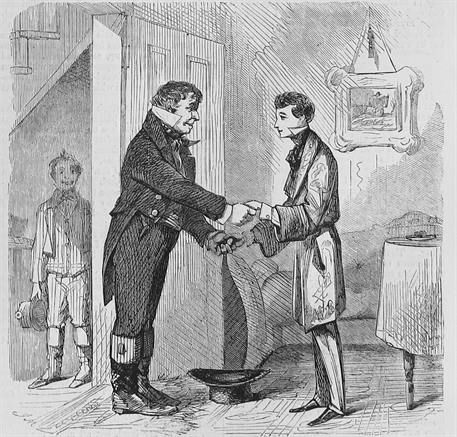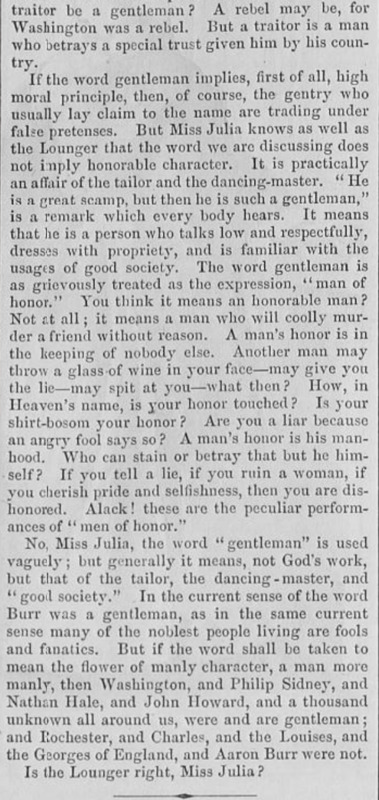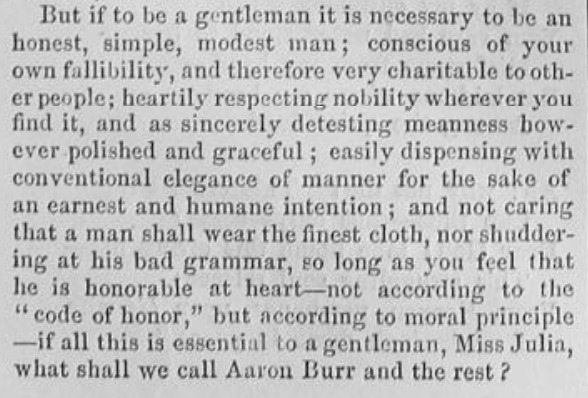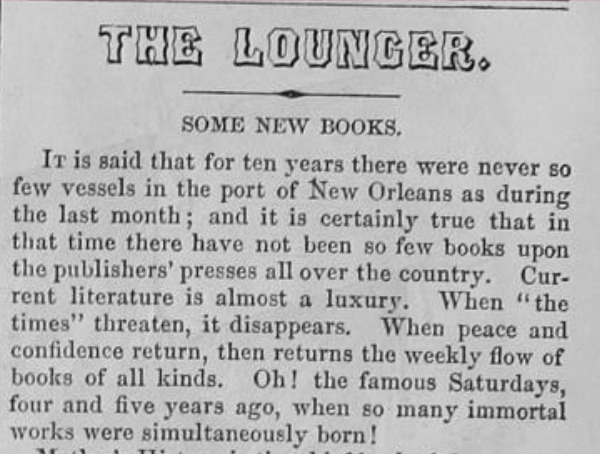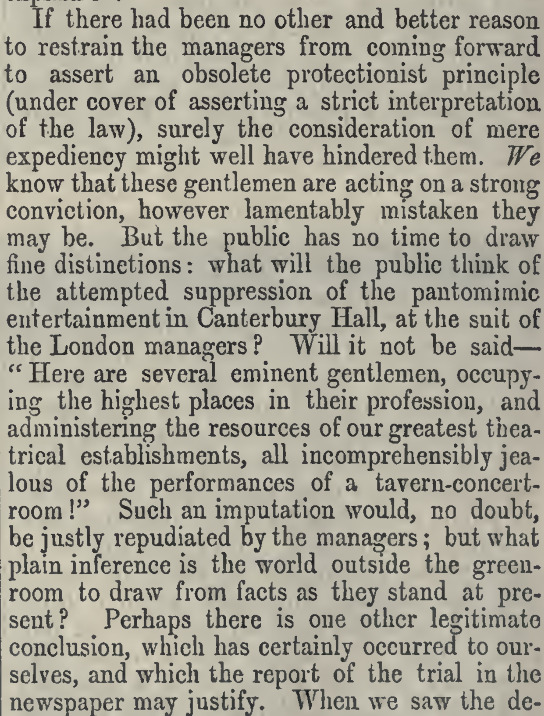Part 17
The Trials and Tribulations of the Gentlemen in the Victorian Era.
Introduction:
Throughout Great Expectations by Charles Dickens, he explores themes regarding society through the qualities that define a gentleman in the Victorian era, such as social standing, refinement, and manners. We often see this development through Pip, whose dreams of being a gentleman are provoked by his interactions with Miss Havisham and his love for Estella. These interactions highlight the importance of social class and education in determining one’s status as a gentleman. Yet, at the novel's beginning, we can see the shift in Pip’s morality as he becomes ashamed of Joe, his profession, and his lack of refinement such as his speech. These periodicals explore the themes of being a gentleman through insight into the challenges and appraisals within “Harper’s Weekly” and “All the Year Round,” which coincide with Pip’s struggle to disconnect from the world that he once was part of to the world he strives to be in. Harper’s Weekly presents the column asking “Who is a Gentleman?” which seems like an advice column to explain the characteristics of a gentleman. Alongside, they have a column titled ‘Lounger’ which discusses various different topics, which for March 23, 1861, was “Some New Books.” This prompts the idea of education and refinement associated with the gentleman, and the privilege of books during this time for the ‘poor child’ depicted by Dickens. Interestingly, All the Year Round presents an insight into a manager of a music-hall and the struggle of the Canterbury Music Hall in London during this time. This idea of music-hall vs. other areas of entertainment explores how individuals undervalue the music-hall to bigger spaces such as theatres. This reflects the social difference and the importance of understanding the spaces for these individuals, such as the lengths the writer of this column presents to the viewers who perhaps cannot afford to go into these areas. Pip explores this idea of gentlemanliness and the desire to become part of a society he has dreamed of, avoiding those like Joe who does not match the gentleman level he receives.
"Pip, How Are You, Pip?" In Harper's Weekly.
This print shows just when he enters, greeting him as “Pip, how are you Pip?” with a figure in the background. Although the figure in the background could be Pip’s servant, it also presents a reflection of Pip as a younger boy and the identity he struggles to go against. These sections depict the ideas of what is a gentleman, and how Dickens uses Pip to explore the conflict between worlds: lavish, poverty, self-identity, and expectations. It is important to note that “from the 1830s onward, the middle-class professional men, as their position gained more ground in society, felt the need to adjust themselves to the altered situation. Such men attempted to legitimize modern masculinity by creating a new concept of the gentleman, the epitome of manhood(...)” (Sirkel, 580). These become the ideals for boys in various social classes as “to be regarded as a gentleman depended on people’s judgement” (Sirkel, 581). Not only does this new concept of gentleman-hood is important to the Bildungsroman of boys, but also shows through Dickens portrayal of Pip’s childhood to comment on the social life of children. Furthermore, as he is in the midst of making himself into the gentleman, it furthers the notion of “the modern type of gentleman, often originating from the middle-classes, had to make himself visible by showing his worthiness with the right behaviour and deportment in order to be regarded as a gentleman” (Sirkel, 582). Yet, how does one deem another man to be worthy?
"Who is a Gentleman?" in Harper's Weekly
This column within Harper's Weekly presents the question of "Who is a Gentleman?" to which Dickens almost uses it like an advice column, as it begins with “Julia wishes to know if the Lounger thinks that Aaron Burr is a gentleman.” They go through the characteristics of a gentleman, including to mention the royals such as the Duke of Buckingham or Louis XIV. Yet, at the end of the column, it says that “the word ‘gentleman’ is used vaguely; but generally, it means not God’s work, but that of the tailor, the dancing-master, and ‘good society.’” It argues and gives reason to the behaviours of men and the honour associated with them. Distinctly, Harper’s Weekly presents the perception of a gentleman in Pip's eyes as skewed to his perspective of what he aspires to, and he feels embarrassed about Joe when he enters his new society, making Pip wish that he should have paid him to stay away (Dickens, 248). As previously stated, “to be regarded as a gentleman depended on people’s judgement” (Sirkel, 581) which Pip knows and does not want Joe to be seen in any other light. This column uses this commentary of the ideals of gentleman in their favour; to excuse any different perception of who is a gentleman. Yet, there is briefly a commentary of the different perception of whether or not the woman sees these men as gentleman-like – a woman goes to The Lounger to hear, probably from a man’s perspective, whether or not this man in her life is considered a gentleman.
"The Lounger: Some New Books" in Harper's Weekly
As Harper’s Weekly was an American print, there is a distinction of value and importance to who their audience was. We see the interaction of presenting the ideals of a gentleman, but it continues to discuss the luxury of books during this time. The Lounge reviews books published during this time, describing one of the books to be “one of the handsomest of American books” but admits that “there have not been so few upon the publishers’ all over the country.” It reminisces on the publication of books, and as the Civil War was about to emerge during this time. These books consist of genres like science, art and poetry. In comparison, Dickens uses literature to portrayed children as innocent and vulnerable, yet also capable of great resilience and strength. He highlighted the harsh living conditions and abuse that many children faced, particularly those from impoverished backgrounds, and criticized the lack of protection and support provided by the government and society at large such as he does through Pip. Malkovich argues that “this form allows them to tread relatively unseen in Victorian culture and society as they blend into its background” (62), which is interesting to consider this perception is undermined by individuals as Dickens uses his voice to expose these strings, and in America the affect of the civil war diminished publishing companies yet the books presented are to further knowledge in other areas. Ultimately, these become distinguishing characteristics between the USA periodicals, and the UK’s All the Year Round.
"Managers and Music-Halls" in All the Year Round.
All the Year Round presents a different entertainment than Harper’s Weekly, as the text completely fills the pages. Further into the chapter of Great Expectations within the periodical, Joe tells Pip that Drummel is an actor now (Dickens, p. 249), which further into the novel includes the involvement of the theatre. As the chapter concludes in All the Year Round, there is a column titled “Managers and Music-Halls” right after, which presents a different perspective on the workload that these men should consider, such as those associated with the theatre. This text focuses on working within the music-halls such as: what is a music hall? What do viewers and actors do there? What is the role of a manager? They present this as a division in social class between those who could afford to go and those in poverty. The music theatre they discuss is the Canterbury Music-Hall which was one of the first halls in London (Kift, 17), and “music halls were forced to fight for their existence in the face of the theatres large and small, pleasure gardens, concert rooms and song-and-supper rooms. One of the proprietors’ major difficulties was to establish a distinct image for the music hall was therefore a deliberate act of policy” (Kift, 20). The reader is presented with legalities and arguments, reasons to why the managers are fighting for the music hall and explains to those why it is important and the struggle of the manager’s position to gain the support of the public. Although we can consider that these gentlemen “occupying the highest places in their professions….” it also shows the struggle of division in the entertainment industry, such as music halls.
Conclusion:
Charles Dickens offers a complex and nuanced portrayal of the idea of being a gentleman in the Victorian era through characters like Pip in Great Expectations. While the novel acknowledges the importance of social standing and refinement, it also highlights the flaws and limitations of this ideal and suggests that true gentlemanliness is defined by one's moral character and treatment of others. This can be seen through the relationship between Pip and Joe, as this chapter depicts how he is ashamed of Joe's humble profession as a blacksmith and his lack of refinement. He feels that he is above Joe and desires to become a gentleman to escape his humble origins. Pip's attitude towards Joe reflects the societal norms of the time, which placed great emphasis on social class and education. These periodicals explore this notion of being a gentleman, such as the American periodicals “Harper’s Weekly” uses their sections to highlight the ideals of being a gentleman and briefly comments on the lack of books being published, yet within “All the Year Round” explores how gentlemanly qualities through the professions of individuals and promotes these gentleman professions as well. Furthermore, it utilizes the column to inform those the legalities and issues that these individuals endure. What Dickens teaches his readers through Pip is that the idea of a gentleman is not defined by social class or education, but rather by one's moral character and treatment of others and raises awareness of these issues and encourage social reform to improve the lives of children in Victorian England. Alongside, both periodicals comments on the economcial state through the Civil War and issues surrounding music halls, but nevertheless mentions the importance of gentleman within the economy and how it is vital for their personal and/or public businesses.
Works Cited:
Dickens, Charles, Great Expectations, edited by Graham Law and Adrian K. Pinnington, Broadview Press, 1998.
Kift, Dagmar, and Kift Dagmar. The Victorian music hall: culture, class and conflict. Vol. 10. Cambridge University Press, 1996.
Malkovich, Amberyl. Charles Dickens and the Victorian Child : Romanticizing and Socializing the Imperfect Child, Taylor & Francis Group, 2012. ProQuest Ebook Central, https://ebookcentral-proquest-com.ezproxy.lib.ucalgary.ca/lib/ucalgary-ebooks/detail.action?docID=1125165.
Sirkel, Katri. “The Victorian Gentleman Dandified: Aspects of Dandyism in Charles Dickens’ Bleak House and A Tale of Two Cities.” Interlitteraria, vol. 16, no. 2, 2011, pp. 579–92, https://doi.org/10.12697/IL.2011.16.2.13.
Image Citation:
"Managers and Music-Halls," All the Year Round. March 23, 1861. Dickens Journal Online, p. 558. https://www.djo.org.uk/all-the-year-round/volume-iv/page-558.html
"Pip, How are you, Pip?" Harper's Weekly, Vol. 5 Issue 221, March 23, 1861, p. 181.
"The Lounger: Some New Books," Harper's Weekly, March 23, 1861. Vol. 5 Issue 221, p178-179.
"Who is a Gentleman?" Harper's Weekly. March 23, 1861, Vol. 5 Issue 221, p179.
